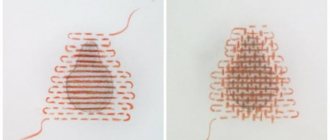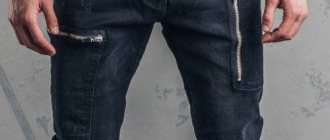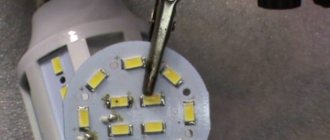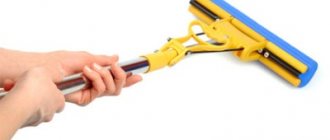For many, jeans are a wardrobe staple. However, regardless of their cost, they wear out over time. The most vulnerable place for a tear to appear is the space between the legs. But you don’t have to throw away your favorite jeans right away; you can increase their lifespan by using a special hidden seam technique and sewing them by hand.
Why do my jeans rub between my legs?
There are several reasons for the appearance of scuffs and holes in jeans between the legs:
- Body shapes. Excessive volume in the hip area, which appears due to heavy weight or increased muscle mass, leads to strong tension in the tissue during wear. In addition, with voluminous thighs, the gap between the inner thighs usually disappears, which leads to pant legs rubbing against each other along the entire length of the thigh.
- Way of walking. A gait in which the legs touch each other on the inside. In this case, the fabric can be rubbed both in the crotch and in the knees.
- Textile. The thicker the fabric, the less one is exposed to external loads. Artificial threads of elastane or polyester make the material stronger. While jeans made from thin denim will not have a long service life, especially if there are other reasons that contribute to the wear of the trousers.
The reasons for jeans rubbing between your legs can be different - from excess weight to poor fabric
- Sedentary work. Sitting still for hours is difficult, so the average person fidgets in his chair from time to time, shortening the life of his jeans.
- Errors when washing. Denim should not be washed in very hot water. Recommendations given by the manufacturer and on the label should be taken into account. If there is no such information, then the water temperature should not be higher than 45°C.
You also need to make sure that when drying, the pant legs are turned inside out and are not exposed to direct sunlight.
Features of the figure
Features of the body structure lead to increased tissue friction:
- close placement of the hips;
- excessive muscle development in athletes.
In some people, the thighs are in close contact and constantly rub when walking, leading to thinning of the material.
Gait features
The way your legs are positioned when walking contributes to the wear of denim - the fabric wears out equally for those who mince with small steps and waddle.
Material quality
The lightest and thickest denim fabric wears out. Thick denim rubs more slowly, but creases in the wrong size cause wear. The presence of synthetics protects the material well - the presence of elastane or polyester increases the wear resistance of jeans.
Overweight
Those who are overweight most often suffer from holes between their thighs, especially if they are constantly growing. The seams stretch, the fabric is constantly under stress not only from friction, but also from tension.
Method 1. Sew up the hole with a hidden seam
Below in the picture you can see how to sew two edges, and then by pulling the end thread the seam will hide inside and that’s all.
This method can also be used to sew in larger clothes.
How to prevent the problem
For those who constantly have to deal with jeans that are worn out between their legs, it is useful to remember a few simple rules for preventing the problem.
Choosing the right size
Choosing the right size is the first step in increasing the durability of your jeans. To prevent jeans from fraying, you should not buy tight products. Excessive tension of the fabric, if you want to fit into a smaller size than necessary, provokes wear. With a large size, the folds from excess material rub against each other.
Normal or high fit
Models with a high or normal fit fit the body better, sit naturally, and form fewer creases in the groin area. Experience shows that with a low waist, jeans rub faster.
Proper washing
Jeans should be washed in the recommended washing machine mode, without exceeding the temperature, without excess detergents and chemical stain removers, with the zippers turned inside out and zipped up. Do not fill the drum with several products at once - they will damage each other.
If your jeans are already torn, it is better to wash them in a special bag.
Option 3
If desired, the flaw (hole) can be turned into a “highlight” of the jeans. So, if a small hole appears on your children’s jeans (your beloved child got caught on something while out for a walk), then it can easily be turned into a bright ladybug. No special skills are required from you - just the ability to hold a needle in your hands.
You will need red and black floss threads, a needle and scissors. Draw a circle around the hole using a coin. Immediately divide it into 2 parts - head and abdomen.
Now thread a red thread into the needle and start embroidering the abdomen from the middle with stitches (in stockinette stitch). After this, immediately make a dividing strip with black thread and move to the head. At the end of the work, make antennae and legs using separate stitches. Make black dots on the wings using knots. The ladybug is ready. No one will even guess that she is covering the hole.
Emergency help
What to do if you urgently need to put on jeans and run errands? And, as luck would have it, the denim has frayed in the area between the legs? Don't panic. You can use an ambulance. There are special round-shaped adhesive patches. It is enough to fix them on the wrong side of the damaged area using an iron. This method is good when you need to prevent the formation of a hole. But keep in mind that the method is not designed for a long time. It will help only when the defect appears in an unforeseen situation.
Sooner or later the moment will come when the jeans will tear again and you will have to throw them away. But one Dutch resident couldn't accept the fact that he had to give up his Levi's trousers. He carefully patched them up for eight years. You can see the result for yourself. The wardrobe item began to bear little resemblance to the original. But the designers liked this idea, and they began to produce similar models that could be bought in one of the Amsterdam clothing boutiques. And the Dutchman who came up with all this became the embodiment of stubbornness.
Knee patch
It often happens that the pants are still good, but a fray or hole has formed on the knee. Thanks to patches, it became possible to hide such imperfections and give the product a “fresh” appearance.
To put a patch on your knee, you need to stitch the patch along the entire edge with single-color threads. After this, apply it to the damaged area. First, it must be sewn to the product with an overlock stitch, and then attached to the fabric by hand or using a sewing machine.
How to put a patch on your knee
How to repair ripped jeans by hand
There are several ways to repair torn tissue. In case of minor damage, the places where the tears are made are reinforced with pads; if the holes are significant, a denim patch is applied.
Tip: Jeans lovers should not throw away old worn-out items - they will come in handy for repairs.
General sewing tips
If the problem of holes and abrasions in jeans between the legs is constant, then it is recommended to strengthen this area of the pants immediately after purchasing the product and washing it for the first time.
Also, you should not wait until the abrasion turns into a hole or a small hole becomes a big one. Taking preventive measures will increase the service life of jeans.
You should carefully consider the choice of fabric for the lining. For example, thick material or thick denim can subsequently chafe the body, especially if the jeans model is narrow. To make the repair of trousers less noticeable to others, you should take the time to find sewing threads that match the color of the fabric.
What you need for work
For hand sewing you need the following materials and tools:
- patch fabric;
- threads;
- needles.
Seamstresses advise working with household needles, which are sold in a set. To sew up a hole without a sewing machine, use numbers 11 and 14. The threads are also chosen thicker.
Cotton threads from 50 to 80 numbers or from 50 to 60 numbers (synthetics) are suitable. You can also use a sewing machine to repair a hole in your pants.
How to properly make patches on jeans by hand: instructions, tips
a patch fixed with pins on jeans before sewing on by hand.
Patches vary in appearance and functionality:
- decorative - inserted in place of a torn place, looking like a flap on the main canvas,
- double - have different sizes and the same shape. They are applied to the damaged area from the front and back sides, followed by sewing each to the jeans fabric,
- invoices are the most short-lived, since they are sewn on top of the hole on the front side of the product.
Before putting a patch on jeans:
- wash them and those scraps of fabric that you will use as patches
- Dry the jeans completely, iron them and especially those seams closest to where the damage is located.
- cut patches from scraps of fabric in the required quantity and shape
- mark the repair areas with chalk, especially if you need to place patches on both legs
- remember and practice a hidden seam on a piece of fabric, if necessary
- plan seam allowances around the perimeter of the patch
- if necessary, pre-process the edges of the patch with a zig-zag stitch or similar
- After sewing, be sure to wash the jeans
- First, choose a fabric for it of the same material, color and texture. An acceptable option is also from old jeans of a slightly darker shade.
- Cut the patch so that it completely covers the hole and has gaps for the seams.
- Place it on the front side of the main fabric. Pay attention to the fabric pattern of the patch and the main fabric. They must match.
- Attach with pins around the perimeter.
- To be safe, baste the patch in the corners.
- Using narrow, small stitches, carefully move along the edges of the patch.
- Remove the pins and spread the auxiliary thread.
- Turn the jeans inside out.
- Sew the same stitches around the hole. This will secure it. It will not be able to disperse and destroy the tissue further.
Sew patches while slightly damp to avoid fabric deformation and wrinkles.
To ensure that your patches on jeans look neat after hand sewing, consider a number of points:
How to carefully sew a patch on jeans between the legs by hand?
neatly hand-sewn patches between the legs of jeans
Algorithm of actions
Let's look at the sequence of work:
- Jeans and patch fabric are washed and ironed (except for adhesive materials).
- Turn the product inside out and determine the size of the required patch. The size of the prepared piece should be larger than the total area with holes of 0.5-0.7 centimeters around the entire perimeter.
- Sew the cut piece from the inside out with a basting stitch, make sure there are no folds, bubbles, and all holes are carefully covered with a patch.
- Depending on the type of patch material, iron it with an iron (adhesive) or make multiple seams using the plastering method.
It is not difficult to install such patches, but these methods are used to repair minor damage and slightly worn areas. Therefore, restoration work begins immediately after minor abrasions appear.
Patches
The matter will stop unraveling if you put a patch on the wrong side. Craftswomen cut a piece of fabric of the same shade (the material of any old denim item will be useful). A couple of horizontal cuts are made on it, which will be identical in size to the hole.
Afterwards, the seamstress carefully pulls out the longitudinal threads. When the holes match, step back a centimeter from each side and cut out a patch. Then the workpiece is placed under the abrasion and sewn with small stitches. In this case, the color of the thread is selected to match the denim.
Replacing the damaged area
To sew up jeans discreetly by hand, craftsmen completely replace the torn part of the item, maintaining symmetry. To work, you will need 2 shades of thread: to match the color of the fabric and threads whose color matches the factory ones.
How to sew clothes correctly:
- To begin with, the back and side seams of the pants are partially ripped out.
- Then cut out the rubbed part.
- Then the fabric for replacement is cut out. However, its shape must be identical.
- The cut out part is applied to the prepared scraps and identical blanks are cut out.
- Next, all the flaps are basted and sewn in so that the patch on the pants looks neat.
In order for the item to retain its appearance for a long time, the sections for the inserts are cut out in such a way that the guide threads are located diagonally. This way the material will stretch well.
Seamstresses use not only denim or stretch fabrics, but thick corduroy or leather inserts. They will look more harmonious if there is a patch on the legs, and not just in the crotch area. It is cut from the same material.
Japanese technique "Boro"
The technique originated in the Middle Ages in the Land of the Rising Sun. Boro art consists of numerous parallel stitches of equal length, hand-crafted. They resemble darning with coarse threads. For ease of use, needlewomen advise using long needles.
- To repair damage to jeans, choose thin denim, cotton or linen fabric.
- To work, choose a flap of any shape. The seam allowance should be 3-4 cm.
- Finish the outline of the cut or hole with forward stitches using a needle. In this case, the damage will not stretch further.
- Parallel to the outline of the hole, use a washable felt-tip pen to draw parallel lines for future embroidery. The distance between them can be 0.6-0.8 cm.
- From the wrong side, baste the prepared patch.
- Apply smooth stitches along the marked lines, which should be longer on the front side than on the back side.
- You need to turn the stitch onto the next row from the wrong side. Continue embroidering in the opposite direction.
- Make several rows of stitches on the bottom and top of the patch of different lengths, as well as on the sides.
The cuts on the flap can be slightly frayed if the flap is sewn on the front side of the product. To add style to the patch, you need to choose different stitch lengths and thread colors.
Blind stitch patch by hand
If the hole has formed on the knee, and it is large enough, during the repair process you should follow the step-by-step instructions below:
- Trim the threads sticking out around the perimeter without going into the fabric.
- Turn the jeans inside out and circle the hole, making an indentation from the edge of about 2-3 cm. If possible, it is better to process the edges of the hole not with your hands, but with an overlocker. But in this case the patch will be more noticeable.
- Prepare the self-adhesive tape by cutting it to the desired size. Do the same with a piece of fabric for sealing your pants. Ideally, you should cut it diagonally in the direction of the weave of the thread. Thanks to this, the fabric will not unravel or fray.
- Glue the web and denim patch using a heated iron. Steam the patch a little, especially around the edges.
- Sew around the perimeter of the pants patch using blind stitches.
- Turn the jeans right side out and make the correct horizontal stitches. The most suitable stitch for this would be a zigzag stitch.
- Cut off the excess threads and the repair is complete.
Repair without patches
How to sew up a hole in jeans beautifully? There are several ways for which you do not need to make patches. They are simple to perform, and if you learn how to do it, you can quickly and easily restore worn-out material.
Darning by hand
How to mend a hole in jeans? With this method of repairing things, frayed threads are replaced with new ones. To do this, darn along the worn area.
If there are factory threads left on the fabric, then pass the needle first under and then over them.
When the row ends, a needle is threaded from the end through several threads on a whole piece of material. At the same time, the gaps from the edges of the torn material should remain minimal, but should fix the fabric well. This way, the darned area will be less noticeable, and the denim will stop unraveling.
Usually craftsmen do a continuous stitch: this way the darning will be dense and more durable. Then they continue to mend the hole, but not along, but across. First, the needle is passed under the thread, which is located perpendicularly, then over all the following ones. The seamstresses make sure that the stitching is tight and there are no gaps. If this condition is met, and the color is matched tone to tone, then the repair will be barely noticeable.
How to mend jeans between the legs by hand instead of using a machine? To accurately repair jeans, each thread must be suitable in density, texture and shade. It is best to take them from the bottom of the trouser legs that need to be sealed. This method is suitable for restoring worn-out, sometimes see-through clothing. Often such areas appear if denim wears out over time. Craftswomen easily mend small holes with torn edges.
Plastering
This method is used if jeans need to be closed by hand unnoticed. Seamstresses use it when sewing the edges of fabric. This is usually used to repair clothing that has been cut or torn by a sharp object.
Craftsmen know how to sew up a hole without a sewing machine. Such a hole can be round in shape. The plastering method is used most often.
There are several ways to repair various types of damage:
Blind seam
Jeans can be hand-stitched discreetly. Craftswomen advise using a hidden seam for this. This method is suitable in cases where the trouser legs are torn at the stitching site.
For example, they can disperse from behind or from the side. It happens that some parts have come off: patch pockets or a belt loop.
If apart from this there are no other defects, and the trouser legs remain intact and not frayed, then two or three hidden seams on the fabric completely eliminate the damage and remain invisible. This technique is also used if you need to hem the trouser legs at the bottom. Such repairs may be necessary when restoring worn edges, fixing the hem from the inside, or stitching the bottom part.
Materials for patching
Specialized stores offer beautiful and original blanks of various shapes, sizes and shades, fabrics and leather. If it is necessary to repair the product as discreetly as possible, then pieces of original fabric are sewn on.
The material is taken from the leftovers after cutting long legs or cut out under the pockets, replacing it with fabric of a similar color and density.
To mask abrasions and extend the life of denim, adhesive material is used. The part is glued like this:
- cut out a piece of fabric covering the problem area;
- put an adhesive pad and a new patch on the wrong side of the jeans, iron them with a hot iron;
- To add strength, the part to be repaired can be stitched.
Torn pants have not gone out of fashion for several years. Such models are decorated with a variety of patches.
Old clothes will look feminine and attractive if you attach lace or guipure fabric to the inside. The material should match the color of the main fabric.
You can decorate women's or children's pants with satin stitch embroidery. These can be floral ornaments, flags, figures of animals or birds.
Cartoon characters are a great design option for little children. The main thing is that the decor looks harmonious and emphasizes the image of the owner.
Darning on a sewing machine
It is usually easier to mend jeans between the legs using a machine than by hand.
Such repairs will also be more durable:
How to mend jeans between legs using a sewing machine
- Then you need to cut out a piece of denim that matches the color and preferably the thickness. The part should be 1 cm wider than the hole.
- The patch should be secured on the wrong side with pins and sewn on with a few stitches on a machine. It is not recommended to baste the patch by hand, as it will be extremely difficult to remove the basting threads after darning.
- You should darn from the front side, placing the seams as close to each other as possible. Ideal if you can repeat the direction of the denim threads.
- Next, you need to fill the surface with stitches running in a perpendicular direction.
How to properly make patches on jeans using a machine: instructions, tips
jeans under the foot of a sewing machine before sewing on a patch
A patch sewn to jeans using a sewing machine looks neater, especially if you placed the first one in a visible place.
The technique of attaching patches in this case has its own differences.
When sewing a single piece of fabric, perform the preparatory work:
If you are patching your knees, place the patch on the front side. For symmetry and aesthetic perception of jeans after repair, sew symmetrically on a piece of fabric on the second leg.
How to carefully sew a patch on jeans between the legs using a machine?
Standard Patches
How to quietly sew up a hole in jeans? To do this, ordinary fabric patches are placed on top of the worn material. You can cut out a fabric square, attach it, iron it and secure it with pins. In this case, there should be a centimeter left for the hem on each side.
Then the part should be ironed, bending the edges and secured to the jeans. This method can be difficult to apply if the trouser leg is torn in hard-to-reach places. Sometimes seamstresses rip out factory stitches to better secure patches.
Repairing Holes with an Overlay Patch
- Cut off any loose threads from the hole.
- Use a buttonhole stitch to stitch the hole to give it a neat look.
- Choose the material of the desired color.
- Cut a flap of a certain shape, which should be larger than the size of the hole.
- Tuck the cuts in it by 1 cm.
- Baste the prepared patch from the front side.
- Sew on the patch using a sewing machine.
The hole can be treated with a patch, which is decorated with fringe on all sides.
Repairing holes with a backing patch
- Cut a patch of a certain shape, larger than the size of the hole.
- Baste it from the wrong side with the right side facing up.
- Select threads of a certain color and zigzag along the hole several times. The selected color of thread will make the patch on the jeans between the legs invisible.
You can also bend the cut edges of the hole to the wrong side. Sew from the right side of the folded edge of the product.
Read more: how to sew pants between your legs and prevent the formation of new holes.
Useful tips and tricks
To carefully remove unsightly scuffs on jeans between the legs, you must follow these rules:
Important! In order for the denim material to remain in its original form for as long as possible, products made from it are not subjected to frequent washing, which is best done by hand.
How to install a patch
There are two ways to mend jeans between your legs using a machine.
Classic version
It is easy to close a hole or abrasion by making a regular fabric patch over the damage. The square patch is quick and easy to sew on, which is why it is the most popular.
To make a square patch, you need to cut out a square from the fabric that will cover the hole, leaving 0.5-1 cm for the hem. Then the part should be ironed, bending the edges and secured to the jeans. Experienced craftswomen can use pins for this.
For those who are not confident in using a sewing machine, it is better to baste the patch by hand. Next, the square must be sewn to the jeans, placing the seams around the perimeter of the workpiece.
This method can be difficult if the hole is in a hard-to-reach place. In this case, you can simplify the work if you slightly open the nearest factory seam. After the hole is sewn up, all that remains is to carefully stitch the seam, choosing threads of the desired color.
Recovery
It is possible to mend jeans between the legs using a machine even when the damage is large and the patch option is no longer suitable. To do this, you should use the restoration method, which consists of completely replacing the damaged part of the product. In this case, the replacement should be made symmetrically.
To work you will need:
- pieces of denim of a suitable color,
- threads of 2 colors: to match the jeans and matching the threads used to make the seams on the jeans by the manufacturer.
Stages of work:
- It is necessary to rip out part of the back seam running in the center, as well as the side seams.
- Cut out the frayed section of the pants.
- Next, on the other side of the back seam, cut a piece of fabric identical in shape.
- The cut piece of jeans should be attached to the prepared flaps and symmetrical parts should be cut out.
- Then all the details need to be basted and carefully sewn into the jeans.
To prevent the jeans at the crotch from fraying longer, it is recommended to cut the insert parts so that the guide threads run diagonally. This will allow the fabric to stretch better.
You can also strengthen your jeans if you use thick corduroy or leather rather than denim. To make the insert look natural, you can sew patches from the same fabric in other places on the jeans.
Other repair methods
A hole in your jeans is not always a reason to be upset.
If you approach the problem creatively, you can create interesting and fashionable things.
Beautiful patches on jeans, ideas with photos
The quality of the fabric itself is poor
Not only excess weight or full hips can cause the product to lose its beautiful appearance. Those who own jeans with artificial abrasions may quickly become upset that the product will quickly become unusable. The fact is that such fabric is usually very thin. Therefore, it cannot withstand constant friction, washing, use and wears out many times faster than the dense version. If the fabric is supplemented with polyester or elastin, thanks to which it can stretch somewhat, then the product will last a little longer.
How to prevent jeans from rubbing between your legs
You can prevent trouble if you follow simple rules.
If possible, avoid using fabric softeners, bleaches, fabric softeners, stain removers and laundry soaps.
Option 2
If your jeans are torn at the seam, use just a little effort and they will look almost like new. To repair, you will need a thick thread (don't worry if you don't have the right color: it won't be visible anyway) and a needle.
Cut off the old threads with scissors. Next, tightly, so that there is no displacement, fold both parts and sew them to each other with a hidden seam, making small stitches on the front side and large ones on the back. Once the hole is stitched, simply pull the thread and secure the edge.
Lifehacks to help prevent scuff marks:
- When buying, choose the right size, you can take a looser one.
- Give preference to pants with a medium or high waist; they are less likely to wear out quickly.
- Fidget less in your chair.
- Wash your jeans properly: hand wash or delicate wash will do. They need to be turned inside out, fastened with a zipper and buttons, and not washed too often.
- At the first sign of scuffing, take it to a workshop or, if possible, fix the problem yourself.
- Buy several pairs of pants and wear them alternately, this way you will increase the service life.
- Try purchasing quality custom made jeans.
Treat with paraffin
Rub clean or washed jeans (preferably new ones) with colorless paraffin. Pay the most attention to the seams. Apply only from the front side and, with active wear, repeat the procedure once a week.
If there are pellets in the treatment area, they should be removed with a blade or nail scissors.
Why do jeans have a fifth pocket? Everything is not so obvious! History + interesting fact
Sew on the pantyhose flaps
Resourceful girls claim that if you sew scraps of old tights on the inside, your jeans will last much longer. Of course, you need to act carefully so that the seam is not noticeable from the front side. Alternatively, you can take your favorite pair for an “upgrade” to the nearest studio.
Option 5
Another option is jeans with an incredible number of holes. If you don’t want to throw them away, but wearing them is not very comfortable, then you can slightly modify them.
Take the guipure and cut out pieces slightly larger than the holes. Turn the jeans inside out, attach guipure to them and secure along the edges with tailor's pins - this will make your work easier.
Turn your pants inside out and start sewing. The color of the threads should match the color of the jeans as much as possible, then the seam will be almost invisible. Stepping back about 0.5 cm from the edge, place small stitches along the entire perimeter. For ease of use, place paper or cardboard between the legs. This will help you avoid accidentally sewing two pant legs together. After sewing, carefully trim off the excess guipure.
Other damage to jeans
Holes and terry are fashionable decorative elements of many jeans models. They are good only for young people - on vacation and parties. For those who love neatness, holes in the knees and buttocks have to be repaired.
How to remove a hole in a pocket
Jeans pockets often get worn out. Rear due to friction against outer clothing or chairs. Holes may appear on the front ones when there is a habit of keeping your hands in your pockets or carrying small things in them.
Jeans will look fashionable if you don’t hide the hole, but rather emphasize it. The only thing to keep it from spreading is to secure the edges.
The hole can be given any shape, for example, made in the shape of a heart. Small wear on the pocket can be hidden behind embroidery done with simple stitches. Embroidery and appliqués allow your imagination to unfold as much as possible.
There are many ways to sew jeans between your legs. For some it is easier to do this on a machine, for others it is better to sew by hand. If you have no sewing skills at all, you can glue an applique.
Patch on jeans on knees
Decorating a hole in the knee is very simple. In the old days, such patches spoke of poverty, but today the situation has changed. A patch on the knee will add a special chic to your jeans. Moreover, it can be placed both on a real hole and on new jeans. This will be an individual haute couture piece. You will not see such a thing anywhere. Women, men and children can “revive” jeans and give them originality. Of course it is possible. Give your jeans a fashionable look by making holes in other places. But not everyone is happy with this look.
How to remove a hole in your butt
Holes do not always need to be darned or sewn up using classical methods.
Damage to pants on the butt, hidden behind bright appliqués or embroidery, often looks more interesting and natural.
How to sew a hole in the back pocket of jeans
It is not difficult to disguise a torn area, considering that manufacturers decorate them with embroidery or stripes. You can do the same: cover the hole with artistic embroidery with woolen or floss threads, glue an applique, or use a sewing machine for monochrome artistic darning.
Pockets often tear in the corners due to constant pulling down if a person carries bulky items there - a set of keys or a wallet. If a hole has just appeared, it can be easily closed with an over-the-edge seam. The main thing is to choose threads that match the fabric.
If the hole is of a decent size, then first rip off the pocket and mend the torn area. Then they return the pocket to its place and sew it on by hand or on a sewing machine.











